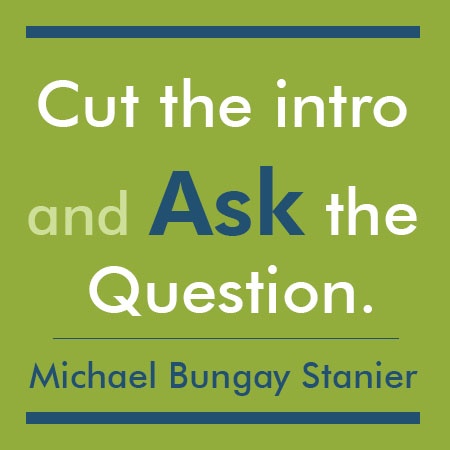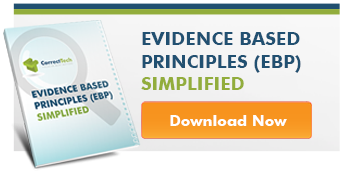When considering where to start formulating a practice model, I happened upon The Coaching Habit: Say Less, Ask More and Change the Way You Lead Forever. I love the title. It is so packed full of important concepts; coaching, habits, listening, asking, changing you, leadership and the future. Wow, if that’s the title, imagine all of the ideas covered in this brilliantly simple book by Michael Bungay Stanier. While in the past I’ve questioned the actual importance of coaching vs. the rise of the rhetoric and number of coaching books, after reading this book I am a believer. If you read one book about coaching, make it this one.
Read MoreEvan C. Crist, Psy.D.
Full Bio
Recent Posts
Put a Coaching Habit at the Heart of your Practice Model
Posted by Evan C. Crist, Psy.D. on 6/29/18 7:18 AM
Topics: Motivational Interviewing, client development, Listening Skills, The Coaching Habit, Michael Bungay Stanier, Community Corrections Client Services
Developing a Practice Model
Posted by Evan C. Crist, Psy.D. on 12/28/16 3:02 PM
This blog is a continuation of the EBP Practice Models blog series started by this blog’s author Evan C. Crist, Psy.D. and other industry leading authorities on practice models, Brad Bogue, Matt Moore and Tom O’Connor.
When Brad Bogue first suggested we work on a “practice model” I was embarrassed to admit I had no idea what he was talking about. After a bit of research I realized that, while the term was foreign to me, the concept was not that complicated and was a logical extension of our agency’s evidence-based practices (EBP) training. I learned that practice models structure the use of various EBPs into a logical, coherent process to help practitioners identify the next necessary step in the intervention sequence.
Armed with lots of knowledge about EBP, but without a framework to identify and organize what techniques to use when, we recognized we did, indeed, need a practice model. Since I am writing this blog during the Christmas season, it seemed that we had lots of ornaments and tinsel but no tree on which to hang them. It became clear that without a practice model we would remain knowledgeable about EBP but unskilled in their delivery.
I looked at several of the prepackaged practice models available but found all of them lacking. They were either incongruous with my clinical experience (e.g., the importance of building motivation was essentially ignored) or contradicted my philosophy of the change process (e.g., they followed a manual but left little room for situational flexibility). With Brad at my side challenging my assumptions every step of the way, we decided to develop a practice model in house. We facilitated the process while our capable staff of case managers merged research with their experience and theory with reality.
It was a vital learning experience for me. I thought I needed to teach the case managers to think; turns out, I simply needed to create the space and let them think.
We started with the necessary requirements for the practice model:
- It must include a variety of interventions.
- It must include evidence-based, evidence-informed or promising practices.
- It must be coherent.
- It must be simple but powerful.
- It must include situational flexibility.
Topics: Policy, Practices, Change, Community Corrections Client Services, Developing a practice model, Evan C. Crist
Why Practice Models are the Next Big Thing in Community Corrections
Posted by Evan C. Crist, Psy.D. on 12/15/16 1:44 PM
Note from the editor: This blog is a continuation of the EBP Practice Models blog series started by this blog’s author Evan C. Crist, Psy.D. and other industry leading authorities on practice models, Brad Bogue, Matt Moore and Tom O’Connor.
This blog has two parts.
Part I, The Changing Function of a Case Manager, paints a picture of how the role of community corrections practitioners is constantly changing as the field and its stakeholder’s expectations evolve and expand.
Part II, More Effective Treatment, explains the need for a coherent intervention strategy based on logic and research to help case managers do the treatment oriented work we are expecting more and more from them. We suggest Practice Models are the answer to our need for this intervention strategy. Although EBP has been viewed by some as a nuisance, adding more work to already overloaded case managers, read below to see how we think differently.
PART I – The Changing Function of a Case Manager
Case Manager or Psychologist? Or both?
As a participant of community corrections for the better part of two decades, I’ve noticed an interesting and predictable shift in the industry. Yes, it is becoming more treatment oriented, but the change that I find more interesting is the shift to teaching paraprofessionals to deliver specialized services generally allotted for master’s level or doctoral level therapists.
I’ve seen this happen throughout my psychologist career and I don’t think it is good or bad, rather a normal progression of a maturing industry that needs to provide more services to a larger population without the benefit of a significant increase in government funded resources.
But why?
Read MoreTopics: Evidence Based Practices, Change, Practice Models, Treatment
Getting to the Point in Community Corrections
Posted by Evan C. Crist, Psy.D. on 9/27/16 9:18 PM
Getting to the Point
The top of a pyramid is what makes it identifiable as a pyramid. This apex is known as the capstone. On ancient pyramids, capstones were given special care and sometimes made of gold. Kings had their names etched in them. Pyramids are architectural marvels. While many mysteries and legends abound, experts agree that the building of the pyramids took hundreds of workers hundreds of years to complete.
While pyramids served many purposes (some were quite elaborate on the inside with bakeries, tombs and hallways aplenty) the outward symbol of success was to get to the point, the capstone. Once the builders completed the point of the pyramid, it was complete. Any shortcuts would certainly be noticed and mar the elegance of these ancient structures. If the work crews had rushed to get to the point, it is unlikely that these landmarks would still be standing.
Read MoreFocusing on Effective Offender Transitioning in Community Corrections
Posted by Evan C. Crist, Psy.D. on 6/16/16 12:30 PM
My 15-year-old daughter has her driver’s permit. She is attentive and cautious, but sometimes being in the car with a learning driver is a bit harrowing. She is slowly becoming more comfortable and confident but still needs guidance at times and frequent feedback for assurance. She will have her license soon, but, for now, this learners’ permit experience serves a great transition from being an unlicensed driver who still needs Dad to play taxi driver to a licensed driver who believes she needs nothing from no one.
Learning the necessary skills to earn that freedom is not without stress for driver and passenger, but imagining what the roads would be like without such a transition period is certainly far more frightening.
Transition Clients Back into the Community
Thoughtful planning, basic skills training and the freedom to make some mistakes are vital aspects of a good transition for community corrections offenders too. In fact, it can be argued that the lack of such a process is largely to blame for our unacceptably high recidivism rate.
Read MoreTopics: Evidence Based Practices
Subscribe To Our Blog
Recent Posts
Posts by Topic
- Community Corrections (61)
- Evidence Based Practices (44)
- Community Corrections Professional (23)
- Software (15)
- Practices (12)
- Change (11)
- Technology (10)
- Risk Principle (8)
- reentry (8)
- probation staff (7)
- EBP (6)
- Outcomes (6)
- client development (6)
- client needs and values (6)
- coaching community corrections clients (6)
- Assessment (5)
- Community (5)
- Developing a practice model (5)
- Justice-Involved Clients (5)
- Remote work (5)
- The Coaching Habit (5)
- parole (5)
- risk (5)
- tele-supervision (5)
- tele-work (5)
- Community Engagement (4)
- Evan C. Crist (4)
- Community Corrections Client Services (3)
- Criminal Justice Reform (3)
- Implementation (3)
- Listening Skills (3)
- Motivational Interviewing (3)
- Policy (3)
- Positive Reinforcement (3)
- Practice Models (3)
- high risk client (3)
- reaching clients emotions (3)
- responsivity (3)
- Addiction (2)
- BOP (2)
- Conferences (2)
- ICCA (2)
- Management (2)
- Michael Bungay Stanier (2)
- Relapse Prevention (2)
- halfway house (2)
- jic (2)
- principles (2)
- procedures (2)
- program results (2)
- APPA (1)
- Appreciative Thinking (1)
- Brian Lovins (1)
- COVID-10 (1)
- Community Connection (1)
- Coronavirus (1)
- Crisis (1)
- Customer Service (1)
- Data Management (1)
- Fidelity (1)
- ICCA Seattle (1)
- Juvenile Corrections (1)
- Leadership (1)
- Monitor History (1)
- Opioid Addiction (1)
- Opioid Crisis (1)
- Orange is the New Black (1)
- Program Data (1)
- Reforms (1)
- Relapse (1)
- Second Chances (1)
- Switch by the Heath Brothers (1)
- Treatment (1)
- drug testing (1)
- going paperless (1)
- govcio outlook (1)
- impact sessions (1)
- innovation (1)
- intrinsic motivation (1)
- justice reinvestment (1)
- marijuana testing (1)
- money savings (1)
- opiod testing (1)
- paperless office (1)
- purpose (1)
- remote working (1)
- resources (1)
- sanction (1)
- staff productivity (1)
- technology solutions provider (1)
- the awe question (1)
- what works (1)
- what's on your heart (1)
- work from home (1)







